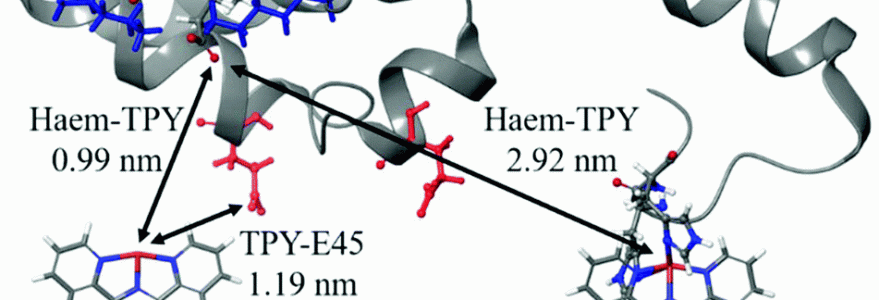How to convert solar energy into green electricity or green fuel? How to make the process of artificial photosynthesis more efficient? The answer to these questions was developed by a research team led by Prof. Joanna Kargul and Dr. Margot Jacquet from the Center of New Technologies at the University of Warsaw. Scientists have created a universal chemical platform for the nanostructuring of electroactive proteins. The researchers’ article was published in “Nanoscale”.
The construction of an efficient conductive interface between electrodes and electroactive proteins is a major challenge in the biosensor and artificial photosynthesis fields to achieve the desired performance of various types of nanodevices.
As a major step towards this ambitious goal scientists report in the journal “Nanoscale” the rational design and novel bottom-up approach to building a highly conductive interface based on metallo-organic terpyridine wires forming a uniform and well-structured self-assembled monolayer (SAM) on the transparent conductive electrode composed of indium tin oxide (ITO).
“We show for the first time that the TPY-ligand-SAM can be successfully used as a universal platform for the specific anchoring of the model electroactive protein (cytochrome c). The ITO-TPY nanosystem reported in the RSC Nanoscale, even without the biotic electroactive component, generates photocurrents whose densities are 30-fold higher than those reported for the pristine ITO electrodes and 2-fold higher than the best-performing electrodes functionalised with the biophotocatalysts such as photosystem I. Thus, the development of a universal chemical platform for nanostructuring of electroactive proteins reported in our study provides a major advancement for the construction of efficient (bio)molecular systems requiring a high degree of precise supramolecular organisation as well as efficient charge transfer between photoactive molecular components and various types of electrode materials to ensure maximised power output,” explains Prof. Joanna Kargul from the Solar Fuels Laboratory at CeNT, co-author of the publication.
Artificial photosynthesis devices and biosensors
The highly conductive photoactive nanosystem described by the researchers in “Nanoscale” fully based on non-toxic and earth-abundant elements and operates in water-based electrolyte without external mediators, which makes it attractive for future upscaling of sustainable artificial photosynthesis devices and biosensors.
This interdisciplinary, collaborative effort combining experimental and theoretical studies was led by Prof. Joanna Kargul, with the great contribution of Dr. Margot Jacquet as the lead author (Solar Fuels Lab, CeNT UW), and involved several groups from the Faculty of Chemistry/CNBCh UW, CeNT UW, Institute of Organic Chemistry PAS, and Institute of Electronic Materials Technology / Łukasiewicz Research Network.
Publication details:
Jacquet M, Izzo M, Osella S, Kozdra S, Michałowski PP, Gołowicz D, Kazimierczuk K, Gorzkowski MT, Lewera, A, Teodorczyk, M, Trzaskowski B, Jurczakowski R, Gryko DT, Kargul J (2021), Development of a universal conductive platform for anchoring photo- and electroactive proteins using organometallic terpyridine molecular wires, “Nanoscale”, https://doi.org/10.1039/D0NR08870F



